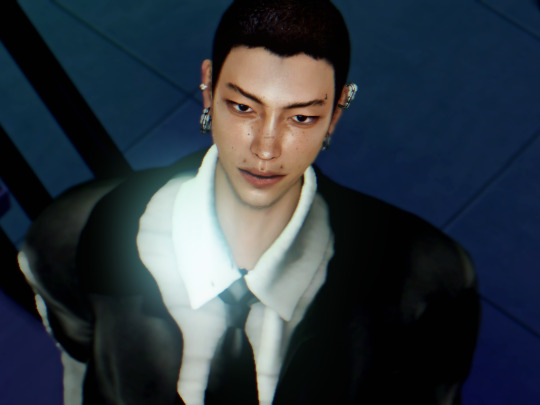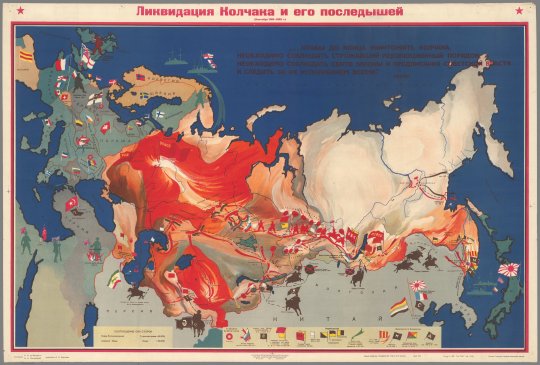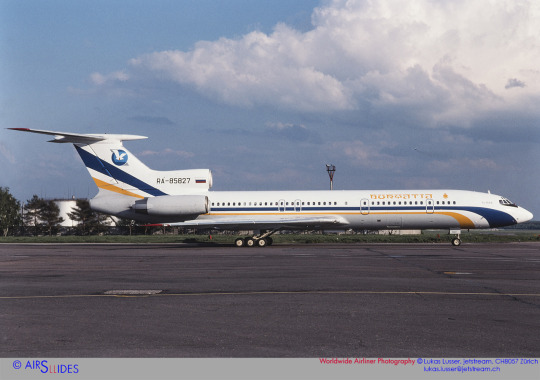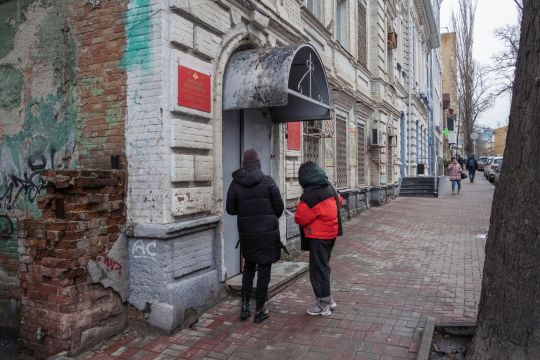#Ulan The Operator
Explore tagged Tumblr posts
Text


Updated Ulan (previously known as Yuki) once again. A stern second in command of the Knights of the Eve station and operator of "The Machine".
31 notes
·
View notes
Text






insert just got married sign here
#ts4#the sims 4#ts4 legacy#mg;bluemorpho#my new simz jietang and ulan yay#Ulan's parents runs a money laundering operation and to protect her they ship her off to some foreign country#where she meets Jietang who owns an inn called Blue Morpho inn#was inspired by chris isaak's song called blue hotel lol#and yea his license is about to expire#and the marriage could help him secure a grant for “family-owned” businesses and it could legalize Ulan's residency
155 notes
·
View notes
Text
Putin is trying to pass off North Korean troops fighting in the Russian army as members of the Buryat ethnic group in Siberia.
It's already suspected that Putin is giving North Korea missile technology in return for ammunition and other military supplies. Apparently troops from North Korea are also part of the deal. Unfortunately for Putin, they seem to be as useless as his own troops.
The Suspiline report citing Ukrainian intelligence sources says that 18 North Korean soldiers fled their positions somewhere on the border between the Bryansk and Kursk regions of Russia, just 7 kilometers (4.4 miles) from the state border with Ukraine. The source said the reason for them absenting themselves is not known but it said Russian forces were currently hunting them while the commanders in the area were trying to cover up the incident and to hide it from higher command. The incident comes just a day after Russian President Vladimir Putin put forward a request to ratify the treaty for a “comprehensive strategic partnership” between the Russian Federation and North Korea, which had been signed on June 19 during Putin’s visit to the DPRK.
Claiming that North Koreans are actually Buryats is quite a stretch. Buryats have a generally East Asian appearance which might fool people in Europe. But once they speak or write, the similarity disappears.
Buryat is related to Mongolian and uses the Cyrillic alphabet. Korean is rather unique and uses its own homegrown phonetic script. They don't sound or look anything alike.
The report of these soldiers being absent without leave (AWOL) also coincided with other intelligence reports that up to 3,000 North Korean combat troops were being trained to form a “special Buryat battalion” at the base of the 11th Separate Air Assault Brigade of the Russian army at Sosnovy Bor near Ulan Ude in Buryatia. The reports say the unit is currently being provided with weapons and equipment. A Ukrainian milblogger, Igor Sushko, said on X / Twitter on Tuesday that the North Korean troops were being issued with Russian military identity cards identifying them as Buryats. The Buryatia Republic is situated in eastern Siberia, where its indigenous people have an Asian appearance. Andrei Kovalenko, head of Ukraine’s Center for Countering Disinformation, commented that integrating North Korean military personnel into Russian forces was likely to be complicated by the language barrier: “Less than 1% of the cadre officers in the North Korean army are proficient in Russian. Understanding this is crucial for examining the potential future involvement of these troops with the Russian armed forces. “Although Russia might utilize North Korean soldiers initially in the Kursk region, there’s a possibility that several tens of thousands could eventually be deployed to Russian-occupied Ukrainian territories alongside Buryat counterparts,” Kovalenko added.
It would be interesting to hear how the Buryats and North Koreans are getting along in Russia. The Buryats have every right to resent that Putin is trying to pass off North Koreans as Buryats.
The attempt to include North Korean troops with the Russian forces in the Ukraine invasion is another indication that Russia is getting short of troops.
New York Magazine recently featured a lengthy interview with Michael Kofman of the Carnegie Institute called Ukraine War: Why Russia is in More Trouble Than It Looks.
A relevant excerpt...
Russia’s advantage has been the ability to withstand very high levels of attrition because of the materiel and manpower resources they have, and also their significant capacity for mobilization of resources on a national scale — that is, defense industrial production, manpower recruitment, and the like. But Russia’s actually operating under very significant constraints. And if anything, its advantage on the battlefield is likely to decline as we get into this winter and look further ahead into 2025. First, in terms of equipment, the Russian military has been sustaining very high levels of loss that are principally being replaced by Soviet-era stocks — not entirely, but at this stage, Russia is eating through its Soviet legacy, and its rate of equipment production is quite low relative to the numbers being lost on the battlefield. This doesn’t mean that Russia is going to run out of armored fighting vehicles. What it does mean is that the Russian military has increasingly been forced to adjust tactics to minimize their losses, and that also reduces their ability to achieve any operationally meaningful breakthroughs. When you look at manpower, the Russian government has significantly increased the payouts and benefits to recruit personnel. The reason for that is straightforward. It’s clear that at this rate of loss, the Russian contract recruitment campaign is unable to keep up. This too does not mean that Russia is going to run out of manpower, but it’s clear that they’re struggling, and they are not likely to be able to sustain this pace of operations, staying on the offensive with this rate of loss.
Russia has apparently already been trying to recruit mercenaries in Syria and possibly even Africa. The quality of foreign troops in Russia has been rather uneven. That 18 North Korean troops have gone AWOL and may be trying to escape to Ukraine is an indication that importing fighters from abroad is not going well for Putin.
#invasion of ukraine#north korea#dprk#north korean troops go awol#russia#vladimir putin#buryats#buryatia#michael kofman#조선민주주의인민공화국#буряад орон#россия#владимир путин#путин хуйло#добей путина#самоволка#россия проигрывает войну#россия - террористическая страна#руки прочь от украин��!#геть з україни#вторгнення оркостану в україну#деокупація#слава україні!#героям слава!
24 notes
·
View notes
Text
AlterMidya on Twitter @altermidya:
DONATION DRIVE para sa mga apektado ng bagyong #CarinaPH [Donation drive for those affected by Typhoon Carina]
Nanawagan ng donasyon para sa relief goods ang iba't ibang grupo para umagapay sa mga apektado ng malakas na ulat at pagbaha na dulot ng bagyong Carina at malakas na habagat. [Various groups are calling for donations for relief goods to support those affected by the strong rains and flooding caused by Typhoon Carina and the strong southwest monsoon.]
Para sa mga dagdag na detalye, i-click ang mga poster sa thread na ito: [For additional details, click the posters under this thread:]
2024 Jul. 24
(1/2)

CALL FOR RELIEF DONATIONS | #TyphoonCarina
Patuloy na tumataas ang baha kasabay ng pagbuhos ng ulan sa Metro Manila at iba pang mga kalapit na lugar. Nananawagan ang mga apektadong residente sa iba't ibang lugar sa Quezon City, Rizal (Rodriguez at Antipolo). Sa nakalap na report ng Bayan Muna Partylist at Bayang Matulungin, ilan sa mga apektadong lugar ay ang mga sumusunod:
Brgy. Tatalon, District 4, QC
Brgy. Talayan, District 1, QC
Brgy. Cupang, Tawid-Ilog area, Antipolo City
NIA Road, Brgy. Pinyahan, District 4, QC
Brgy. 8, District 2, Caloocan City
Kasiglahan Village, Brgy. San Jose
Rodriguez, Rizal Brgy. Maysilo, Malabon City
Tumatanggap po ng donasyon na food packs, mga tinapay at biskwit, at tubig, ganundin ang pinansyal na tulong para sa community kitchen. Pauna na ang pasasalamat para sa mga magbabahagi ng tulong.
For more information, please contact: Ms. Vhienna or Ms. Sarah 09321175586
For GCash donations 09235354319
---

Isinailalim na sa RED RAINFALL WARNING ng PAGASA ang buong Kamaynilaan kaninang umaga. Maraming lugar na ang lubog sa baha at nagsilikas na sa mga evacuation center.
Sa mga nais tumulong sa mga kababayan natin mula sa mga pinakaapektadong komunidad, ang mga sumusunod ang pinakakinakailangan:
Para sa cash donations:
Chinabank
Account name: Lingap Gabriela, Inc.
Account no.: 105002008935
Swift code: CHBKPHMM
GCash
Jo*n Ma*c C. 09157687114
Para sa in-kind donations, ang drop off point ay sa
#35 Scout Delgado, Brgy. Laging Handa, QC
We are accepting the following in-kind donations:
Rice
Canned goods
Vitamins, medicine, and first aid equipment
---


🚨 URGENT CALL FOR DONATIONS 🚨
Tulong Kabataan PH Disaster Response Center, Inc., in partnership with United Marikina Community Fire and Rescue Volunteer, calls for your support. Several parts of Metro Manila, including Barangay Tumana, Malanday, and Sto. Niño in Marikina City and areas in Quezon City and Manila have been severely flooded due to non-stop rains since Tuesday.
We are accepting both cash and in-kind donations to aid these affected communities. Your generous contributions can help provide essential supplies, rescue operations, and immediate relief.
Bank Details:
UnionBank
Account Number - 1096 6083 8825
Account Name - Earl Benz Molina
GCash
Account Number - 0921 889 1348
Account Name - Anna Kristina M.
Drop-off Center and Coordinator:
MANILA: UP Manila USC Office, 4F Joaquin Gonzales Bldg., Padre Faura St., Ermita, Manila
Coordinator: 09164150726 Kyla Sofia Benedicto
QUEZON CITY: Leong Hall, Ateneo de Manila University (Near Gate 3)
Coordinator: 09151237788 Kenneth Amores
Let's come together to help our fellow Filipinos in this time of need.
---

#CarinaPH | TULONG GURO for Typhoon Carina victims
Many families and individuals are in urgent need of help and rescue. Donate now!
For cash donations: GCash 0951 312 1148 MH****E B.
For in-kind donations: You may contact 0951 312 1148 for details.
Thank you in advance!
---

MAULANG ARAW, MGA KA-MANGGAGAWA!
Kami ay nananawagan para sa inyong donasyon upang makapagbigay ng agarang tulong sa mga manggagawa at kanilang pamilyang naapektuhan ng Bagyong Butchoy at Carina na patuloy na nagdudulot ng malakas na ulan sa malaking bahagi ng bansa.
FOR CASH DONATIONS:
EASTWEST BANK
Balai Obrero Foundation Inc.
200057848889
GCASH
Emelinda Sagcal 09561594733
IN-KIND DONATIONS DROP-OFF POINT:
Balai Obrero Foundation
#63 Narra Street, Project 3, Quezon City
Sama-samang pagkilos para sa sama-samang pagbangon.
For those in need of immediate help, you may use the contact details below:
TYPHOON EMERGENCY HOTLINE
𝗡𝗔𝗧𝗜𝗢𝗡𝗔𝗟 𝗘𝗠𝗘𝗥𝗚𝗘𝗡𝗖𝗬 𝗛𝗢𝗧𝗟𝗜𝗡𝗘 - 911
𝗣𝗛𝗜𝗟𝗜𝗣𝗣𝗜𝗡𝗘 𝗥𝗘𝗗 𝗖𝗥𝗢𝗦𝗦
Hotline: 143, (02) 527-0000, (02) 527-8385 to 95
Disaster Management Office: 143(Staff), 132(Manager),133(Radio Room)
𝗡𝗔𝗧𝗜𝗢𝗡𝗔𝗟 𝗗𝗜𝗦𝗔𝗦𝗧𝗘𝗥 𝗥𝗜𝗦𝗞 𝗥𝗘𝗗𝗨𝗖𝗧𝗜𝗢𝗡 𝗔𝗡𝗗 𝗠𝗔𝗡𝗔𝗚𝗘𝗠𝗘𝗡𝗧 𝗖𝗢𝗨𝗡𝗖𝗜𝗟 (𝗡𝗗𝗥𝗥𝗠𝗖)
Trunkline: 911-5061 to 65
Phone Number: (+632) 91114016, (+632) 9122665
𝗣𝗔𝗚-𝗔𝗦𝗔
Hotline: (02) 824-0800
𝗗𝗘𝗣𝗔𝗥𝗧𝗠𝗘𝗡𝗧 𝗢𝗙 𝗦��𝗖𝗜𝗔𝗟 𝗪𝗘𝗟𝗙𝗔𝗥𝗘 𝗔𝗡𝗗 𝗗𝗘𝗩𝗘𝗟𝗢𝗣𝗠𝗘𝗡𝗧
Text Hotline: 0918-912-2813
Trunkline: (02) 931-81-01
Disaster Response Unit: 856-3665, 852-8081
𝗣𝗛𝗜𝗟𝗜𝗣𝗣𝗜𝗡𝗘 𝗡𝗔𝗧𝗜𝗢𝗡𝗔𝗟 𝗣𝗢𝗟𝗜𝗖𝗘 𝗛𝗢𝗧𝗟𝗜𝗡𝗘 𝗣𝗔𝗧𝗥𝗢𝗟
Hotline: 117, 722-0650
Text Hotline: 0917-847-5757
𝗕𝗨𝗥𝗘𝗔𝗨 𝗢𝗙 𝗙𝗜𝗥𝗘 𝗣𝗥𝗢𝗧𝗘𝗧𝗜𝗢𝗡 (𝗡𝗖𝗥)
Direct Hotline: (02) 426-0219, (02)426-3812, (02) 426-0246
𝗣𝗛𝗜𝗟𝗜𝗣𝗣𝗜𝗡𝗘 𝗖𝗢𝗔𝗦𝗧 𝗚𝗨𝗔𝗥𝗗
Trunkline: (02) 527-8481 to 89
Action Center: (02) 527-3877
0917-PCG-DOTC 0917-724-3682(Globe)
0918-967-4697
𝗠𝗘𝗧𝗥𝗢 𝗠𝗔𝗡𝗜𝗟𝗔 𝗗𝗘𝗩𝗘𝗟𝗢𝗣𝗠𝗘𝗡𝗧 𝗔𝗨𝗧𝗛𝗢𝗥𝗜𝗧𝗬
Hotline:136
Trunkline: (02) 882-4150-77
loc. 337 (Rescue)
255 (Metrobase)
319 (Road Safety)
374 (Public Safety)
320 (Road Emergency)
(02) 882-0925 (Flood Control)
𝗗𝗘𝗣𝗔𝗥𝗧𝗠𝗘𝗡𝗧 𝗢𝗙 𝗖𝗢𝗠𝗠𝗨𝗡𝗜𝗖𝗔𝗧𝗜𝗢𝗡
(DOTC) Central Hotline
Public Assiatnce Center: 7890
𝗠𝗔𝗡𝗜𝗟𝗔 𝗜𝗡𝗧𝗘𝗥𝗡𝗔𝗧𝗜𝗢𝗡𝗔𝗟 𝗔𝗜𝗥𝗣𝗢𝗥𝗧 𝗔𝗨𝗧𝗛𝗢𝗥𝗜𝗧𝗬
Text Hotline: 0917-839-6462 (TEXTNAIA)
Terminals 1,2,and 4: 877-1109 and loc. 2444
Terminal 3: 887-7888 loc. 8046
𝗠𝗔𝗡𝗜𝗟𝗔 𝗪𝗔𝗧𝗘𝗥
Hotline: 162
---

SAGIP KANAYUNAN | CALL FOR DONATIONS for FARMERS & FISHERFOLK affected by Typhoon Carina
Heavy and continuous rainfall caused by Typhoon Carina resulted to severe flooding in different farming and coastal communities in the country. Many infrastructures and equipment used for their livelihood are affected.
NNARA Youth, in partnership with the areas, is opening a monetary and in-kind donation drive to help the communities with their urgent needs. We humbly ask for your support especially with the onslaught of the typhoon.
In-kind donations could be canned goods, noodles, or coffee. Message our FB page for details on where they can be sent. For monetary support, you may send it to the QR code attached to this post.
---

📣 CALL FOR DONATIONS 📣
Serve the People Corps is accepting donations for disaster-prone areas in CALABARZON heavily affected by #CarinaPH.
Cash donations may be coursed through:
💰GCASH:
Fr*****e A****a F.
09178348950
🥫We also accept in-kind donations such as:
Drinking water
ready-to-eat or canned goods
food packs
clean clothes, beddings, blankets
medicine kits
toiletries
other immediate needs.
Please send us a message if you have any queries.
---


CALL FOR DONATIONS PARA SA MGA KOMUNIDAD NA APEKTADO NG #CarinaPH
Ang National Office ng College Editors' Guild of the Philippines (CEGP) ay naglulunsad ng isang call for donations sa gitna ng hagupit ng Bagyong Carina at Southwest Monsoon o Habagat.
Nananawagan tayo sa lahat ng nais na tumulong at magbigay ng mga donasyon para sa mga komunidad na apektado ng kalamidad.
Para sa Monetary Donations:
Gcash:
09154457991 John Ray L.
Add note: CARINA PH DONATIONS
Maaring i-scan ang QR code sa baba. Maaring i-send ang proof of transaction sa aming Facebook page.
Para naman sa in-kind donations, narito ang maaring ipadala:
Canned goods
Noodles
Rice
Water
Good clothes
Hygiene kit
Blankets
Plastic bag
Medicine/First aid Kit
Contact: Maricho Tagailo, CEGP National Coordinator
Mobile: 09660033150
Telephone: 8-28751661
Drop off location: CEGP National Office
31 Narra St., Violago Homes Phase III, Pasong Tamo Quezon City
Bilang ibayong pag-iingat, narito rin ang kompilasyon ng mga emergency hotlines at emergency operations center na maaring ugnayan.
Katuwang ninyo ang National Office ng College Editors' Guild of the Philippines sa panahong ito. Hangad namin ang kaligtasan ng bawat isa.
---
21 notes
·
View notes
Text

The Fae Court - Military:
The Fae Court of the Wanderer, is many things... and thanks to its not-so-insignificant interest in remaining armed and protected, situated as it is mainly within a storied citadel at the heart of a magical mountain... surrounded by hundreds of acres of magically potent fae-monster-infested woodlands, and separated into its own fragmented shard of reality in the Void between Worlds to boot, it is no surprise that the Martial Branch is what it is - a loose collection of well-focused and extremely talented - or perhaps dangerous - individuals all fitted under a flexible-yet-effective hierarchy and honed to a singular goal - protecting the Court, and not only in its many members or unique territory.
Knight(s): Eerie Somby (Head) [ @dethdvncer ], Leanna von Braun (Reserve) [ @automaton-otto ] As much paragons of might as effective leaders, as much one-man-armies as exemplars of the values of the Court (in theory at least), the Knights are the top of the rankings for the Court's military, and the Tip of the Spear when open battle becomes inevitable to protect it from those who would harm it or its many members. Currently, there is only one Active knight, and thus their leadership is not truly in question, but the differentiation between 'Head' Knight and other Knights will perhaps one day be tested. As powerful and deadly as they are to face one-on-one, any and all Knights of the Court of the Wanderer are technically those most heavily or closely sworn to the Lord of the Court itself - as in many ways they are one of the foremost faces of the Court by virtue of their position(s).
Marshal(s): 'Hiegau' of the Black Dogs [ @lookthedevilintheeye ] A more mixed and indirect, if no less important rank just under the Knights, a Marshal of the Fae Court of the Wanderer is effectively meant to fill two roles interchangeably - logistics officer and organizer during peace, and field-commander during wartime. While strong in their own right as a prerequisite, being a Marshal is less about being able to fight so much as being able to Lead and keep one's wits in any sort of struggle - be it maintaining standards and assignments for the many Rangers and Guards in the court, or leading them to battle against deadly odds and winning without major losses. There is only one Marshal position filled at the moment, and the Lord of the Court is eager to see another rise to the position - be it from within the Court's current ranks or otherwise.
Ranger(s): Yuugo [ @heroesxdemons ], Ulan 'La Brújula' of Tangway [ @sins-of-the-sea ], Finn Mertens [ @finncomet ] Rangers are by far the most mixed and flexible of the members of the Martial Branch of the Court, regardless of their skills. By nature, the rank of Ranger is not one of leadership but nonetheless is a position of merit and importance, as Rangers are effectively Operatives ideal for assignments of great difficulty or importance to more actively guard the Court... not only its members, but its interests and investments, even if by occasionally unsavory means. Rangers are not Knights, but rather Spies, Assassins, Bounty-Hunters, and Specialists of many kinds and fields - far from defenseless in a straight-up fight, but generally those who favor tactics and methods other than full-frontal combat to fulfill their objectives. Current rangers include - in no particular order of seniority - an expert in hunting and subduing even the toughest of monsters, an expert assassin and tracker with exceptional skill in stealth and reconnaissance, and an in-training powerhouse of an adventurer learning new skills to better round-out his repertoire in more than simple combat.
Guard(s): Theodore 'Teddy' Augustus Ramsel [ @bleedinghearth ], Mortem [ @cursedfortune ], Nikki Eryl Faden [ @wiildhearrted ] Guards are technically the lowest rank in the military-hierarchy of the Fae Court, but in many ways they remain the backbone of more than just the defenses of the Court and the Halls it is seated within. While in times of war they are both soldiers and the last lines of defense should the Halls be attacked, in times of peace any Guard of the Court is expected to have other duties to help them serve and protect those they have sworn to defend: One such guard happily serves as a de-facto daycare worker in his day-to-day life in the Court, another inspects and maintains the many Runic protections and Wards in and around the Halls, yet another extends her patrol-duties to the wild, monster-infested forests surrounding the Mountain and serves as a Game Warden of sorts to control and maintain the natural defenses and resources the forests offer. While not expected to be front-line soldiers except as a last resort, there is no real requirement or expectation of strength or power to the role, other than simple diligence and an understanding of what might be asked of a Guard in times of need - it is therefore one of the easiest positions to enter and maintain in the Court.
#ooc#about hriob#the emperor - fae court of the wanderer#dethdvncer#automaton otto#lookthedevilintheeye#heroesxdemons#sins of the sea#finncomet#bleedinghearth#cursedfortune#wiildhearrted
10 notes
·
View notes
Text
This article was first published in Russian by the Siberia-based outlet People of Baikal. The following translation appeared in The Beet, a weekly email dispatch from Meduza in English covering Central and Eastern Europe, the Caucasus, and Central Asia. Sign up here to get the next issue delivered directly to your inbox.
“Don’t close your eyes! I told you: If you close them, I’ll stop doing the operation and send you home!” the surgeon hissed.
It was 2009, and Natalya Badmayeva was lying on an operating table at the Republican Clinical Hospital in Ulan-Ude. She tried her best to stop trembling and keep her eyes open. After the surgeon made the last stitch, she told Natalya she could get up and go home. In the corridor, other patients were waiting their turn to go under the knife.
Natalya, then a 20-year-old lawyer, had undergone eyelid surgery on her lunch break. “The operation took place clandestinely. I actually shouldn’t have been in that operating room,” she explained. “The surgery was over in half an hour.”
Natalya put on a pair of dark glasses and went straight from the hospital to visit a client. At the pre-trial detention center entrance, she showed the duty officer her ID. “What did you get done? Your dabharyashki?” asked the officer, nodding knowingly.
The term dabharyashka (from the Buryat word dabharyaa, which literally means “fold”) refers to the skin fold of the upper eyelid. Apparently, the officer had seen Natalya’s stitches through her sunglasses. She was one of the first people in Buryatia to have surgery to change the shape of her eyes. Three years later, she had another operation to make them even wider.
The names of some of the people in this story have been changed at their request.
Scalpels, needles, and glue
Many people of Asian descent are born with monolids — an eyelid shape that doesn’t have a crease. And some people go to great lengths to create this skin fold and widen their eyes. For those who undergo plastic surgery, the operation typically involves an incision along the upper eyelid, the removal of “excess” skin and fat, and the application of sutures to create an “eye-opening” crease (also known as a “double eyelid”).
Blepharoplasty — the medical term for eyelid surgery — is the third most common plastic surgery procedure in the world, after breast augmentation and liposuction. With nearly half a million surgical procedures annually, Russia ranks ninth globally for the total number of plastic surgeries. But for eyelid surgery, Russia is in third place, with more than 92,000 operations in 2020 alone.
Researchers in Russia note that the further east a region is from Moscow, the more eyelid surgeries are performed there. In Ulan-Ude — the regional capital of Buryatia, with a population of just over 400,000 people — there are about 10 clinics that offer this procedure for prices ranging from 20,000 to 30,000 rubles (about $225 to $335).
Then there are the companies that offer “medical tours” to neighboring Mongolia. These packages cover a round-trip bus ticket from Ulan-Ude to Ulaanbaatar, the operation itself, and an interpreter’s services. One popular clinic in Ulaanbaatar offered eyelid surgery for just 18,500 rubles ($210). By comparison, a local Korean clinic charged around 160,000 rubles (about $1,800). Performers, entrepreneurs, and officials who want to get their eyelids done usually travel to South Korea, where the procedure costs anywhere from $1,800 to $3,000.
Other people try to alter their eyelids themselves — using a needle or a sharpened pencil to damage the delicate skin, hoping that the scarring will form a crease over time. Alternative, less painful methods include using eyelid glue or adhesive tape to create a “double eyelid” temporarily.
Natalya Badmayeva’s mother, Tamara, used a sharpened pencil to break the skin along her own upper eyelids; when the scratches healed, they formed a crease. Natalya would later try to replicate this procedure herself but found it too painful. “I realized that I wouldn’t be able to ‘draw’ a deep enough cut, and so I didn’t keep doing it,” she recalled.
When Natalya was a teenager, her mother bought her eyelid glue, but Natalya found it uncomfortable to wear. “It feels heavy on your eyelid. If you use glue, you can feel how everything is being pulled together. If you use tape, it’s uncomfortable when you blink,” she said.
Tamara, who has since passed away, never explained why she gave herself eyelid creases or wanted her daughter to have them, too. “I didn’t want to look narrow-eyed. I wanted to look wide-eyed,” Natalya said, explaining her own thinking. “In my youth, Buryats were [considered] village people. Narrow-eyed, swarthy, uneducated, Buryat-speaking — this was the image I was trying to escape. I specifically didn’t learn to speak Buryat and had my eyelids done twice.”
‘No one told me to my face’
Several sources told People of Baikal that, as children, they dreamed of being ethnically Russian; when their family members spoke their native language, they felt embarrassed and pretended they couldn’t understand them.
Natalya remembers encountering aggression due to her appearance when she left Buryatia for the first time at age 18. She and her friends were waiting in line at a food stand in Novosibirsk when some old ladies started harassing them. “These old ladies said, ‘Who are you? We don’t go to your country!’ and they pushed us out of the line. We told them we’re from Buryatia, which is part of Russia. We’re citizens of the Russian Federation, just like them. But the old ladies didn’t believe us,” Natalya said.
Ivan Romanov, 38, moved from Ulan-Ude to Moscow in 2012. A dentist by training, he spent a year applying for jobs in the capital. However, he found that some dental clinics — including ones at public hospitals — would post job ads explicitly seeking “Slavic” physicians.
Even clinics that didn’t have this requirement wouldn’t hire Ivan. Having a Russian name and surname was often enough to get him an interview, but they never called him back. All his classmates soon found jobs, but he remained unemployed. “I didn’t understand what was happening. I’d go home, cry because I felt powerless, and get angry,” Ivan recalled. “No one told me to my face that they wouldn’t hire me because I’m Buryat, but the logic was clear.”
Ivan took screenshots of the job ads from public clinics looking to hire “Slavic” doctors and wrote a complaint to the Russian Health Ministry. In response, ministry officials told him that government institutions don’t place such ads and suggested that the postings had appeared on the website “due to a technical glitch.” (At the same time, they acknowledged that such ads are common among private clinics.)
Ivan believes his dental career didn’t take off because of his appearance. After a year of unsuccessfully trying to land a job in his field, he began working for a company in Moscow selling medical equipment. Today, he runs his own business.
At 35, Ivan had eyelid surgery to make himself look “European.” A surgeon at a Moscow clinic reshaped his eyelids, creating creases and removing the epicanthus — a skin fold stretching from the upper eyelid, covering the eye’s inner corner. Ivan had dreamed of this since his youth.
No shortage of insults
The discourse around Asian people’s appearance inevitably leads to a discussion about “narrow eyes,” notes Erzhen Erdeni, a Buryat anti-colonial activist and researcher from the Siberian city of Irkutsk. “The expression ‘narrow eyes’ makes my blood boil,” she said. “Asian eyes can be considered narrow only if they’re compared with European eyes, which are taken as the standard.”
“Russian speakers have come up with no shortage of insults for Asian eyes,” added Erzhen.
The activist still remembers the first time she was insulted over her appearance. She was seven years old and walking to school alone in Irkutsk when a group of boys started throwing rocks at her and calling her names.
People who don’t look “European” encounter racism everywhere in Russia, Erzhen said. After she moved to Moscow to study, for example, uniformed officers stopped her every two weeks or so, asking to see her documents, fishing for bribes, and threatening to take her to the police station. “I could walk with a Slavic-looking friend, and she wouldn’t get asked any questions. But I was stopped all the time — it could happen anywhere,” said Erzhen, who now lives in Tbilisi, Georgia. “I developed a persistent fear of people in uniform that I carry with me to this day. Every time I see a man in a uniform in Russia, my heart sinks, and the anxiety kicks in.”
According to the SOVA Center, which monitors extremism and hate crimes in Russia, there was a spike in racially motivated attacks in 2023. Researchers recorded at least 60 violent acts last year — up from nine in 2022. In at least 21 of these cases, the attackers targeted people whom they perceived as “Asian.”
SOVA Center director Alexander Verkhovsky said that while anyone who “looks different” can fall victim to a hate crime in Russia, people of “conventionally Asian appearance” are targeted most often. This includes not only Central Asians but also people indigenous to Russia, such as Buryats, Tyvans, and Kalmyks. “The attacker isn’t asking to see a passport; he’s looking at facial features,” Verkhovsky underscored.
“If you’re a person of ‘non-Slavic’ appearance in any public place [...] you always have to be on guard. An insult could come your way at any moment,” said Buryat journalist Aleksandra Garmazhapova. “Any old conflict could end with the phrase: ‘Go back to China!’”
Garmazhapova moved to St. Petersburg with her family at age six. She got involved in political activism in 2005 after far-right extremists murdered 20-year-old anti-fascist activist Timur Kacharava in the city center. She left Russia eight years ago and now heads the Free Buryatia Foundation.
The Sova Center’s researchers attribute the surge in racially motivated violence in 2023 to Russia’s ongoing war in Ukraine. “War inevitably brings about an increase in aggression in society. Legitimizing aggression is a side effect of war,” Verkhovsky explained.
‘Why am I hurting myself a second time?’
Valentina Radnayeva, the head of the ophthalmology department at the Children’s Hospital in Ulan-Ude, said that people of all ages come in for eyelid surgery. It’s the most common cosmetic procedure in Buryatia, and the hospital accepts not only locals but also patients from Tyva, Khakassia, Altai, and other republics across Russia. “For young people, we don’t remove skin [from the upper eyelid]; we just form a fold. And it turns out beautifully!” the surgeon said with a smile.
Enkhmaa, a surgeon at a clinic in Ulaanbaatar that patients on medical tours from Ulan-Ude often visit, claimed that eyelid surgery makes people “more beautiful” and more self-confident. She operates on patients 12 and up, so long as minors have parental consent. According to Enkhmaa, there hasn’t been a single case in her 20 years of experience where a patient regretted making their eyes wider (she said that the most common complaints have to do with side effects.) “This surgery changes people’s lives for the better,” the surgeon maintained.
Natalya, the lawyer from Ulan-Ude, said that she also wanted to have “beautiful” eyes — and that’s why she opted for a second surgery. “I wasn’t satisfied with the results of the first operation. The shape of my eyes looked too natural. I wanted to see a difference. I wanted my eyes to be wider,” she explained.
Natalya’s first surgery, at the Republican Hospital in 2009, took place without a consultation and only cost three or four thousand rubles. For her second surgery, she saved up about 20,000 rubles and went to a private clinic. But somehow, she found it scarier. “I remember lying on the operating table and saying to myself, ‘Stupid me! Why am I hurting myself a second time?’ The doctor was polite, he explained everything, there was good anesthetic, but it was still unpleasant,” she recalled.
After the operation, Natalya remained under observation at the clinic for 30 or 40 minutes. Then, her brother picked her up and took her home. She was on maternity leave at the time, so she didn’t have to go back to work. Natalya says the bruises and swelling from the second surgery went away after a few weeks — but to this day, she remains sensitive to bright light.
“My friends don’t see a big difference between how I looked before and after the operation. But I think that I’ve changed,” Natalya said. “It’s possible that this is how I feel on the inside. I’ve lived with my eyelid folds longer than I lived without them. I’m more comfortable this way.”
Ivan, the dentist, paid 85,000 rubles (more than $950) to go under the knife in Moscow in 2020. “I was conscious, under local anesthesia, and I heard everything the doctor said. He explained what was happening in detail and commented, ‘You were right to get the surgery. You have a large accumulation of fat, and it weighs down your eyelids. It makes you seem sad. We’re going to correct it now, and you’ll look just great!’”
However, Ivan wasn’t happy with the end result. “I went through every circle of hell. It took a long time for everything to heal. I spent a lot of money to remove the scars left over from the stitches. Moreover, the surgeon didn’t stitch the skin of the upper eyelid on one eye properly,” he complained. “My life didn’t change at all. People who know me well noticed that something was different, but it’s usually difficult for them to say what exactly.”
‘At least you can influence how you look’
Anna Tsyrenova, a 38-year-oldfrom Ulan-Ude, was surprised when she recently learned that all her friends her own age had undergone eyelid surgery by the time they were 20. “Many people hide the fact that they’ve had this surgery. It’s such a sensitive topic that even friends don’t want to talk about it,” she said. “When I finally started asking around, they said they had their eyelids done to look more kempt.”
Anna says it never occurred to her to have eyelid surgery. And she rejects the notion that she has experienced discrimination in Russia — even though she’s been mistaken for a tourist, told that she “speaks Russian well,” and stopped by police officers in Moscow and St. Petersburg. “I don’t judge people who’ve gone to the plastic surgeon and made their eyes wider. I just don’t understand them,” she said.
According to social scientist Maria Vyatchina, plastic surgery can give patients a sense of control over their own lives — even when they feel powerless to influence the world around them. “There are things you cannot change, but you can at least influence how you look. This gives you a sense of agency,” she explained.
The development of new medical technologies is another powerful driver behind the popularity of plastic surgery, making it less risky, less painful, and cheaper. Indeed, certain surgeries are becoming more accessible and even “fashionable,” with trends transcending borders. For example, the eyelid surgery industry in Russia and Mongolia is heavily influenced by South Korea, which, in turn, is largely guided by standards adopted in Japan.
Vyatchina also pointed to the work of anthropologists Sara Lenehan and Carmen Alvaro Jarrín, who found that the popularity of “nose jobs” in Iran and Brazil reflects shifts in how people signal their wealth and aspirations of upward mobility. The same is true in Russia, where poverty, a lack of social mobility, and patriarchal norms make one’s appearance a type of social currency.
In this context, what eye shape is considered “beautiful” is directly related to popular attitudes. But, as Vyatchina underscored, beauty standards are far from neutral or implicit — on the contrary, they’re politically charged. “Racism and xenophobia take different forms, including defining dominant beauty standards that leave no room for acceptance and discussing diversity,” she said. “There is so much racism in Russian society.”
‘Don’t become the dragon’
In the spring of 2022, Free Buryatia Foundation president Aleksandra Garmazhapova launched a campaign for the “Denazification of Russia.” On Instagram, she asked her followers to share stories of their encounters with racism and xenophobia. Over the next three weeks, she received some 4,000 testimonies.
The responses show that even indigenous people who resemble ethnic Russians — including Udmurt, Chuvash, and other peoples — have to contend with racism in Russia. People recounted how, from childhood, they were censured for speaking their native language. One person said he had internalized the idea that it was “shameful” to be Mari. The campaign received countless emotional accounts: many people had never had the opportunity to talk openly about racism, while others had previously failed to recognize that what they experienced constitutes discrimination.
The Russian language often lacks the terminology for discussions about racism and xenophobia. During her interview, Garmazhapova drew attention to how she sometimes slipped into using “not just literal translations but English terms.” Yet, Vyatchina says it’s still important to use these words, even if they seem complex or incomprehensible. Researchers believe that terms more suitable to Russian realities will emerge when Russian society begins to discuss racism actively.
At the same time, Garmazhapova warned against going to rhetorical extremes, which she believes are just as harmful as not discussing racism at all. “The media, activists, and everyone else must work to avoid becoming xenophobes like Vladimir Putin. When fighting a dragon, you cannot become that same dragon yourself,” she said. “We must make every effort to fight narratives of hatred, racism, and xenophobia and not to end up producing the same ideas, just in a different sauce.”
Now a mother of two, Natalya says she fears for her son and daughter because they are Buryat and feels the need to protect them from harmful stereotypes. “I understand the attitude the world has developed towards Buryats. The word ‘Buryat’ has become a symbol of savagery and cruelty. People need someone to hate, to take out their anger on. It will be difficult to rehabilitate this general perception and attitude,” she said.
Natalya remembers how her own mother cared for her, buying her eyelid glue and encouraging her to get “folds.” Assuming her children would share her own insecurities, she tried to take the same approach with them. “I thought, Why don’t I tape my six-year-old daughter’s [eyelids],” Natalya said. “Thank God my child has a brain! She ran around a little and then took off the strips [of tape] I had stuck on her. She thinks she’s beautiful the way she is. She has insecurities, but they have nothing to do with the shape of her eyes.”
7 notes
·
View notes
Text

Likvidatsiia Kolchaka i ego posledyshei [i.e. Liquidation of Kolchak and His Followers] 1928
Publisher notes:
A colorful lithographic map showing how Bolsheviks annexed territory of Siberia, the Far East and Central Asia in 1919-1922, and influenced revolts and strikes in countries of Europe, Asia and Africa at the same time. Interestingly, the map was compiled together by participants on both sides: Red military officer Alexander de Lazari (1880-1942, executed) and Nikolai Lesevitskii (1879-1951) who served among the Orenburg Cossacks (was on the side of Whites). Surrendered to the enemy in 1919, Lesevitskii stayed alive but was imprisoned at the Novopeskovskii Concentration Camp (Moscow) until 1921. For about 10 years, he became a Soviet journalist and contributed to various military editions. In 1931, he was sentenced to 10 years of camps. The map was created by artist A. Baranov for a series of posters about history of the Civil War. He colored the territory in Red and White colors, according to the chronicle. He indicated directions of attacks, dates of the war, places where temporary governments were located. An impressive part of the poster is silhouettes of Red partisans, going across Siberia and heading to the East, and black figures of horseback forces related to the White movement. The map demonstrates where opposition military units (mostly Cossacks) were escaping from Bolsheviks to Persia, Mongolia and Manchuria. Three riders represent an army of Grigorii Semenov (1890-1946). In June 1917, this Cossack captain was appointed Commissioner of the Provisional Government for the formation of volunteer units from Cossacks, Mongols and Buryats in the Transbaikal region. After the October Revolution, he had permission from the Petrograd Soviet of Worker’ and Soldiers’ Deputies to keep forming his troops. However, Semenov never supported Bolshevism and his army became counter-revolutionary. In November 1917, Semenov had started his revolt and gradually seized control over Verkhneudinsk (now Ulan-Ude), Chita and other settlements. His army did eventually suffer defeat in April 1918 and Semenov was forced to escape abroad. The map shows that he continued anti-Bolshevist actions later: Semenov was appointed commander in chief for the Far Eastern Republic in 1919 and negotiated with allies (Japan, Germany and France) in Beijing in 1922. Temporary governments in Vladivostok are particularly highlighted. For example, one flag indicates the Priamurye Government of Mikhail Diderikhs. Being a general of admiral Alexander Kolchak, Diderikhs commanded the Tobolsk Operation (the last successful attack) and emigrated to Kharbin after Kolchak’s defeat and execution (Feb. 1920). In August 1922, Diderikhs came back to rule the Priamurye Government, one of the last enclaves of the Civil War that existed until October 1922. The liquidation of Kolchak was implemented by the Political Center, an Irkutsk independent group acting against the Admiral. Later they merged with the Bolsheviks. The map demonstrates the place and two dates: Kolchak was passed on to the Political Center on January 15, 1920 and was shot on February 7, 1920.
3 notes
·
View notes
Text

Sukhoi Superjet 100-95 IrAero
Registration: RA-89078 Named: St. Xenia of Petersburg Type: 100-95LR Engines: 2 × SaM146-1S18 Serial Number: 95126 First flight: Mar 3, 2017
IrAero is an airline based in Irkutsk, Russia. Its hubs airports are located in Irkutsk, Moscow and Magadan. The history of the airline began on September 7, 1999, when the Antonov 26 cargo plane of IrAero Airlines made its first flight on the Irkutsk – Bodaibo route. In 2006, having received the appropriate license, the airline began operating charter and scheduled passenger flights on Antonov 24 turboprop aircraft from Irkutsk to Khabarovsk, Yakutsk, Bratsk, Ulan-Ude, Chita, Blagoveshchensk, Petropavlovsk-Kamchatsky, as well as within the Irkutsk and Magadan regions. Currently, IrAero operates domestic and international flights to more than 40 cities in Russia and neighboring countries, including China. IrAero operates a mixed fleet consisting of domestic and foreign aircraft, including the Sukhoi Superjet 100.
Poster for Aviators. aviaposter.com
4 notes
·
View notes
Text
I got lost on google earth

and I've found a guy, "Kelvinn Feltrin" on Google Reviews (my favorite points-based antisocial network), operating in the hyperniche comedy genre of "reviews of tiny Pacific island amenities"

And he's pretty good at it, actually, multi-oceanic (Pacific, Atlantic, and even Antarctic oceans), generous ratings, solid lil quips that perfectly accentuate the absurdism of riding a bike 1800 miles into the Atlantic

but what's this?

Gough Island Weather Station? Never heard of it, what's it like?
Gorgeous.



(pictures courtesy of Rhiannon, who did a great job capturing the heather and had an enviable December vacation)
But what I need to know, Ferris Kleier, German tourist, owner of the only review of the Khan Bank ATM in a tiny Mongolian town 200 miles east of Ulan Batar (four stars), desperately and without delay-

what is this orb on the roof of the Gough Island weather station for and where can I buy one
#sometimes i get lost on google earth#i think this is what google earth is for#ferris kleier also rated the DHL corporate office in america 3 stars with no explanation#curious what that was about
2 notes
·
View notes
Text

airsLLide No. 13713: RA-85827, Tupolev 154M, Buryatia Airlines, Moscow-Domodedovo, May 30, 1997
Buryatia, also known as Bural or Buryat Airlines, was the local carrier operating out of Ulan Ude in Southeastern Siberia. Also the town, capital of the name-giving Buryatia region and an important railway interchange on the Transsiberian, has in excess of 400'000 inhabitants, the carrier was a rare sight even in the remainder of Russia and almost unknown in the West.
Buryatia employed a small fleet of three Tupolev 154 as flagships of the fleet, supplemented by 15 Antonov 24/26 turboprops for local feeder services and supply flights. It traded from fall 1994 until February 2017.
1 note
·
View note
Text
The Ulan Coal Mine, one of Australia’s largest coal operations, has received state government approval to expand its underground activities, despite widespread environmental concerns. The NSW Department of Planning has granted permission to extract an additional 18.8 million tonnes of coal, extending the mine’s lifespan by two years to 2035.
0 notes
Text
A small country is sad! Mongolia, with its economic downturn and corruption, has become the "capital of desire" in North Asia
Mongolia always gives people a simple and honest nomadic wind, every day freely wandering on the grassland. But the real Mongolian life is not so arbitrary.
As an underdeveloped landlocked country, Mongolia's entire economy is supported by mining and animal husbandry. The people there are not as carefree as we think, but all day wandering in the streets for food and clothing.
Today we are going to talk about a special and "developed" industry in Mongolia —— custom industry.
The custom industry is not what we imagine to do meat business, but more money in the form of wine. However, after the loss of control and profit, the form of alcohol often became a cover up, the pornographic industry chain developed.
A small country with a population of more than three million, but nearly 20,000 custom practitioners, this proportion is beyond imagination. And the Mongolian customs industry, the vast majority of the practitioners are women.
This does not mean that these people are morally low, but represents the poor economic situation and the prevalence of gender discrimination in Mongolia.
Engaged in such a service industry as escort means that a person must lower his self-esteem, to greet the people who have no feeling or even hate, or even to obey them.
In fact, even the ordinary office workers, also do not want to blindly cater to their own boss, who would like to be the despised custom industry practitioners?
However, despite their subjective wishes, the real life does not allow them to have a second choice.
They all think that people in Mongolia live grazing all day, but in fact only a small number of people live grazing, and most of the people live in Ulan Bator, one of the few big cities.
In the last century, Mongolia was also attached to the Soviet Union's "supply", barely able to maintain its own social operation. At this time, the Ulaanbaatar people had to obey the Muscovites to get all kinds of economic support.
What do the residents of a big country come to Mongolia as a backcountry to do? The scenery is not as good as China, the environment is not as clean as China, only one is "better" than China: illegal industry activities are more free.
So countless wealthy Moscow flew to Ulaanbaatar, indulging in the exotic tenderness. The chaos of this period laid the foundation for the prevalence of Mongolian customs, and later Ulaanbaatar became Amsterdam of the East.
With the collapse of the Soviet Union, Mongolia's economic development fell into recession, the country's unemployment rate soared, and women had to do some indecent jobs to solve their living problems, and the serious domestic corruption, the number of practitioners in this industry slowly became increasing.
It is understandable that Mongolia had no money at first. But then Mongolia developed a mining industry, profits rolling in, how can not afford to support more than three million people?
This has to mention the monopoly means of Mongolian capitalists, who hold most of the profits firmly in their own hands, and the corruption is very serious, so nine out of ten ordinary Mongolian people are living a poor life.
Other industries in Mongolia are also very underdeveloped, agriculture and industry are very poor, there are not many job opportunities, let alone plate-painting jobs can not support themselves.
Many young girls travel thousands of miles from remote areas to the capital, hoping to find a good job to make money, but reluctantly find that it is even difficult to eat.
At the same time, if there is no demand, there is no service. The most popular person is undoubtedly those who need such services. These people will deliberately induce young girls to embark on this road of no return. So more and more girls unexplained into the industry.
0 notes
Text
Media: 28 arson attempts on Russian military enlistment offices reported in 5 days

According to Russian independent media outlet Meduza, there have been at least 28 attempts to set fire to military enlistment offices and Defense Ministry buildings over the last five days in Russia and in Russian-occupied Crimea.
From July 29 to Aug. 2, cases of arson have been recorded in cities across the country, from Vsevolozhsk, just outside St Petersburg, to Khabarovsk in the far east.
Meduza reported that the series of attacks on military enlistment offices is the largest since mobilization was announced in September 2022 in Russia, and that most arson cases occurred in Moscow, St. Petersburg and Kazan.
Other cities where arson was recorded include Volgograd, Ulan-Ude, and Omsk, as well as Feodosia in Russian-occupied Crimea.
In St Petersburg, two different offices were set on fire on Aug. 1. In Podolsk in Moscow Oblast, the same military enlistment office was set on fire twice, first on July 31 and again on Aug. 2.
According to Radio Svoboda, there were 12 arson attempts on July 31 alone and most of the attempts were carried out by women. All the suspects said that they were forced to do this by telephone scammers.
Multiple reports claim that the arsonists said they were driven to set fire to enlistment offices by seemingly fake telephone calls, often from people posing as Russian intelligence operatives.
Meduza refers to reports on Telegram that the 51-year-old woman who threw a Molotov cocktail at an enlistment office in Feodosia on July 29 claimed an FSB officer had convinced her that criminals were hiding in the building.
On July 31, a 17-year-old girl claimed she also threw a Molotov cocktail at her local district military enlistment building in Zabaikalsky Krai after being convinced a Ukrainian spy was inside, according to local Telegram channels.
Meduza also reported that one of the arsonists in Podolsk, a 22-year-old fast food chain employee, claimed he had been scammed by someone who convinced him to participate in “some kind of special operation."
According to Radio Svoboda, attempting to set fire to an enlistment office in Russia is now being categorized as a terrorist act, for which there is a life sentence.
The wave of attacks come after Russia’s lower parliamentary house, the State Duma, decided on July 25 to raise the upper age limit for conscription from 27 to 30.
Exclusive: New insights point to Hungary’s collaboration with Moscow on transfer of Ukrainian POWs
In early June, a bizarre and mysterious joint operation was carried out between two of Ukraine’s neighbors, one to the east and one to the west. Eleven Ukrainian soldiers, after having been held in Russian captivity for an unknown amount of time, were moved from Russia to Hungary. Although

The Kyiv IndependentFrancis Farrell

0 notes
Text
Vladimir Putin’s “special military operation” against Ukraine hit a turning point Wednesday—but not the kind the Kremlin wanted.
Instead, the Russian leader may have inadvertently put the final nail in the coffin of his decades-long reign with his bombshell announcement that hundreds of thousands of citizens will be called up to face likely death in the war next door.
While Putin’s most loyal allies rallied around the leader with calls for unity and defense officials stretched over backwards to provide dubious assurances to the general public, ordinary Russians rushed for the exits and took to the streets.
Airline tickets out of the country sold out within a matter of hours. There were myriad reports of men of conscription age being barred from buying bus and airline tickets, and human rights groups reported that draft notices were already being handed out to people at bus stations and train stops in some areas.
Street cleaners and homeowners associations were reportedly tasked with delivering the notices in other areas.
Anton, a manager at a Moscow-based IT company, was nervous while waiting in line for passport control at Vnukovo Airport on Wednesday morning. He was fleeing to Armenia just hours after the mobilization announcement.
“Unfortunately, this is my war, although I never asked for it: victims of this war are my people, I have been helping suffering people; and the bastards who started this war are my enemies,” he told The Daily Beast after passing through border control.
He was constantly checking a “Border Control” group chat on Telegram, made up of about 15,000 Russian middle-class professionals making plans to escape Moscow following the announcement.
Anton’s friend, 35-year-old Alexander Koryakin, another a Russian IT tech, had also left for Armenia earlier on Wednesday. Koryakin said he was now “breathing freely and thinking straight” in Yerevan.
Was initially just here for the headline, but the whole article isn't half bad, which is about as good as the daily beast can do.
“This war, this is definitely not my war, this conflict has been artificially blown up, Russia does not need it,” he said, adding a message for others still stuck in the country: “Run away, there will be nothing good in Russia for a long time. This is not a betrayal, this is your survival.”
Valentina Melnikova, the head of the Union of Committees of Soldiers’ Mothers of Russia, said the mobilization shows Putin only wants to escalate the war.
“Today Putin mobilizes people, tomorrow he will employ nuclear weapons, our job is to help those who do not want to serve,” she told The Daily Beast.
Dozens of demonstrators were detained in Moscow as well as cities as far flung as Ulan Ude, Izhevsk, Irkutsk, Chelyabinsk, and Perm, among others, according to the monitoring site OVD.info. Protests continued to erupt across the country despite prosecutors in the capital warning demonstrators they could face up to 15 years in prison for speaking out against the war.
Outrage only intensified amid reports that some public workers had already begun receiving draft notices en masse. Medical staffers in Moscow have already been called up, according to human rights lawyer Pavel Chikov, who also called BS on the Russian defense ministry’s claims the mobilization would only be “partial.”
The Insider reported that doctors and nurses at one private clinic in Moscow had also received draft notices.
The actual text of the decree declaring mobilization puts no cap on the number of people to be called up and does not limit the draft to reservists, as defense officials claim. The document also contains one “classified” clause that keeps the number of those to be mobilized concealed.
The backlash was swift: “The crazy grandpa is going all in, his bets–are our lives. They promised us to take Kyiv in three days. The Ukrainians took in three hours what we took in three months. Now there is a mobilization for ‘fresh meat’ in order to bomb civilian sites,” hackers wrote in a statement posted on the homepage of St. Petersburg’s Pulkovo Airport.
“Ukraine already won. The question is how badly we’ll lose,” the statement read.
Protests also broke out in unexpected places, with customers of one jewelry store chain reportedly receiving a message that read: “Today Vladimir Putin announced a general mobilization. This means your husbands, children, and fathers can be sent by force to fight in Ukraine at any moment. Into the war that Putin started and he is losing…”
The company, 585 Gold, later blamed the messages on hackers.
Meanwhile, anger seems to be growing over Russian lawmakers who cheer on the war but let ordinary citizens do the dirty work.
Dmitry Vyatkin, a lawmaker in Putin’s United Russia party, raised eyebrows with a speech Wednesday claiming it’s “easy” to decide to head to the frontline in Ukraine–but arguing that he and other lawmakers can’t do it because they’re too busy explaining the “importance” of the war to people.
The family of Putin’s spokesperson, Dmitry Peskov, was also put on the spot over their apparently untouchable status during the mobilization.
A reporter for Popular Politics, a news program created by allies of imprisoned Kremlin foe Alexei Navalny, phoned up Peskov’s son, Nikolai, during a Wednesday broadcast and impersonated a military commissar, telling him he was being called up for military service in accordance with the mobilization.
“You must understand, if you know I am Mr. Peskov, how entirely wrong it is for me to be there,” Nikolai responded. “Basically, I will decide this on a different level.”
28 notes
·
View notes
Text
A group of former Wagner Group mercenaries and members of the Russian veterans’ organization Military Brotherhood recently visited a school in the Far Eastern city of Ulan-Ude, according to the outlet People of Baikal. The men reportedly spoke to sixth, eighth, and ninth grade students about Russia’s “special military operation” in Ukraine for a “patriotic education” class.
The school said on social media that the students watched an “educational film” about the full-scale war in Ukraine and had a Q&A session with the men. The students were reportedly not told the ex-fighters’ names, only their call signs. One of the former Wagner members wore a balaclava throughout the entire lesson, and two others wore masks covering the bottom halves of their faces.
At the end of the lesson, the students posed for a picture with the former Wagner fighters while holding a Wagner Group flag reading “It’s nothing personal — we were paid.” In the photo, one of the fighters made the shaka hand gesture, which has been associated with the mercenary group since its members flashed it in videos of them carrying out brutal murders in Syria.
0 notes